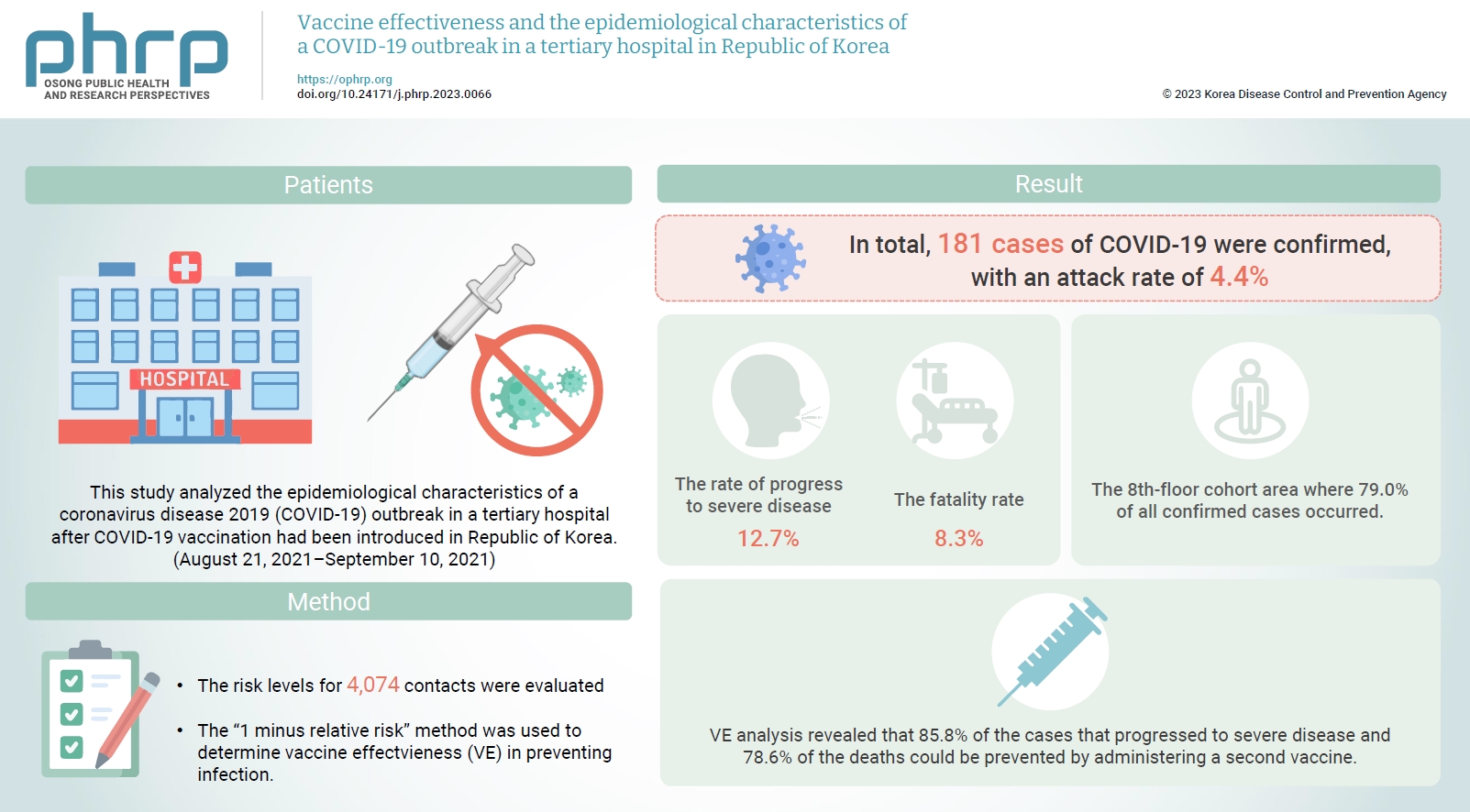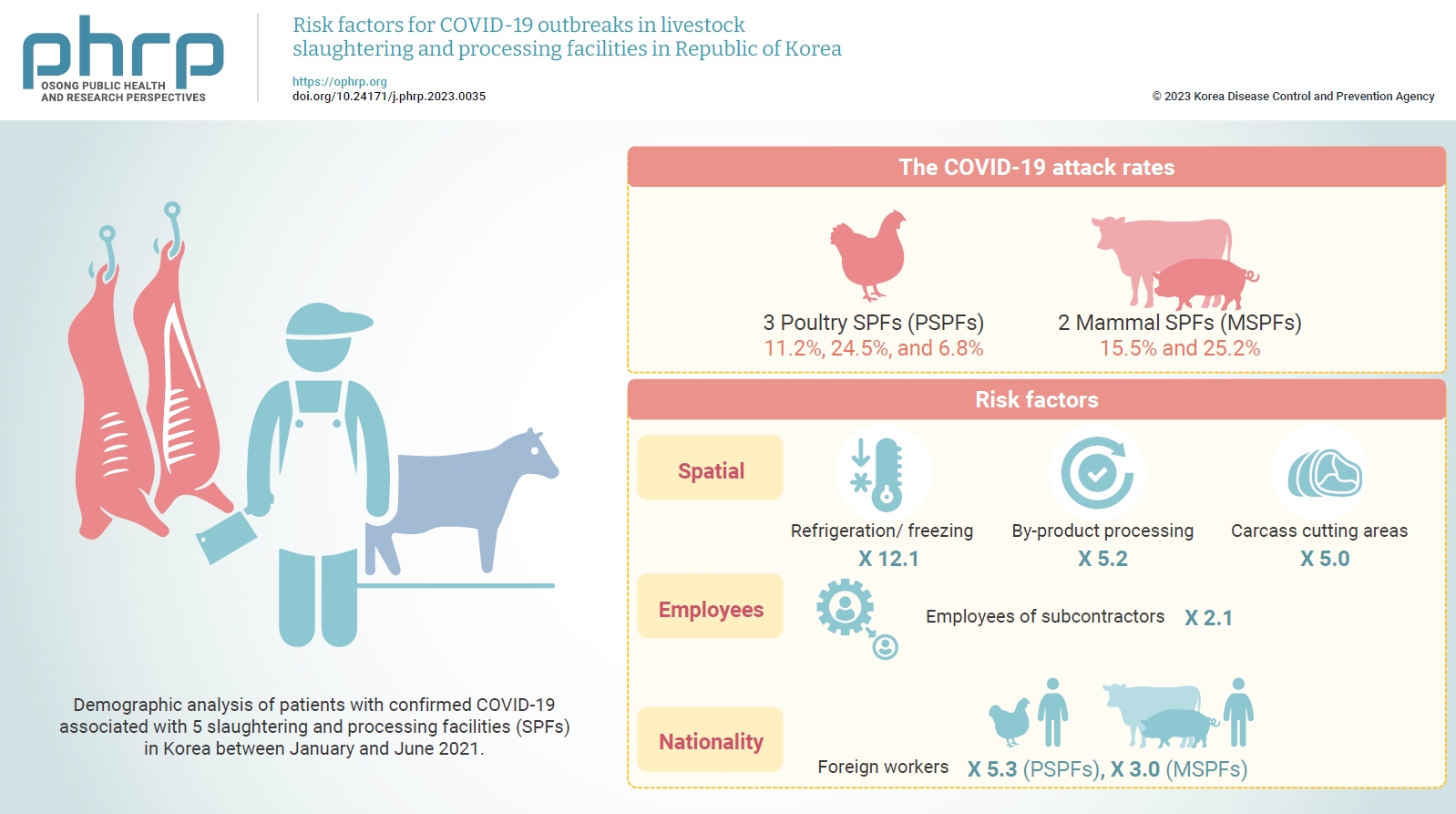Search
- Page Path
- HOME > Search
- Vaccine effectiveness and the epidemiological characteristics of a COVID-19 outbreak in a tertiary hospital in Republic of Korea
- Seonhee Ahn, Tae Jong Son, Yoonsuk Jang, Jihyun Choi, Young Joon Park, Jiseon Seong, Hyun Hee Kwon, Muk Ju Kim, Donghyok Kwon
- Osong Public Health Res Perspect. 2023;14(3):188-196. Published online June 8, 2023
- DOI: https://doi.org/10.24171/j.phrp.2023.0066
- 1,462 View
- 72 Download
-
 Graphical Abstract
Graphical Abstract
 Abstract
Abstract
 PDF
PDF 
- Objectives
Healthcare facilities are high-risk sites for infection. This study analyzed the epidemiological characteristics of a coronavirus disease 2019 (COVID-19) outbreak in a tertiary hospital after COVID-19 vaccination had been introduced in Republic of Korea. Vaccine effectiveness (VE) and shared anti-infection strategies are also assessed.
Methods
The risk levels for 4,074 contacts were evaluated. The epidemiological characteristics of confirmed cases were evaluated using the chi-square test. The “1 minus relative risk” method was used to determine VE in preventing infection, progression to severe disease, and death. In the largest affected area (the 8th floor), a separate relative risk analysis was conducted. A multivariate logistic regression analysis (with 95% confidence interval [CIs]) was used to identify transmission risk factors with a significance level <10% via the backward elimination method.
Results
In total, 181 cases of COVID-19 were confirmed, with an attack rate of 4.4%. Of those cases, 12.7% progressed to severe disease, and 8.3% died. In the cohort isolation area on the 8th floor, where 79.0% of the confirmed cases occurred, the adjusted odds ratio was 6.55 (95% CI, 2.99–14.33) and 2.19 (95% CI, 1.24–3.88) for caregivers and the unvaccinated group, respectively. VE analysis revealed that 85.8% of the cases that progressed to severe disease and 78.6% of the deaths could be prevented by administering a second vaccine.
Conclusion
Caregiver training for infection prevention and control is necessary to reduce infection risk. Vaccination is an important intervention to reduce the risk of progression to severe disease and death.
- Risk factors for COVID-19 outbreaks in livestock slaughtering and processing facilities in Republic of Korea
- Seongju Choi, Tae Jong Son, Yeon-Kyung Lee
- Osong Public Health Res Perspect. 2023;14(3):207-218. Published online June 8, 2023
- DOI: https://doi.org/10.24171/j.phrp.2023.0035
- 1,227 View
- 48 Download
-
 Graphical Abstract
Graphical Abstract
 Abstract
Abstract
 PDF
PDF 
- Objectives
The goal of this study was to help prevent and control the spread of coronavirus disease 2019 (COVID-19) by identifying transmission routes and risk factors in livestock slaughtering and processing facilities (SPFs) and establishing an optimal intervention strategy for outbreaks.
Methods
This case series study was a demographic analysis of patients with confirmed COVID-19 associated with 5 SPFs in Korea between January and June 2021. Additionally, in a retrospective cohort study, the association between COVID-19 infection and risk factors was analyzed for SPFs at which outbreaks occurred.
Results
The COVID-19 attack rates were 11.2%, 24.5%, and 6.8% at 3 poultry SPFs (PSPFs) and 15.5% and 25.2% at 2 mammal SPFs (MSPFs). Regarding spatial risk factors, the COVID-19 risk levels were 12.1-, 5.2-, and 5.0-fold higher in the refrigeration/ freezing, by-product processing, and carcass cutting areas, respectively, than in the office area. The risk of COVID-19 infection was 2.1 times higher among employees of subcontractors than among employees of contractors. The COVID-19 risk levels were 5.3- and 3.0-fold higher in foreign workers than in native Korean workers in the PSPFs and MSPFs, respectively.
Conclusion
As the COVID-19 pandemic continues, a detailed policy for infectious disease prevention and control intervention is needed, without interrupting economic activities. Thus, we propose an ideal intervention plan to prevent COVID-19 through disinfection and preemptive testing and to block its transmission through effective contact management during outbreaks at SPFs.
- COVID-19 outbreak and risk factors for infection in a taekwondo gym in the Republic of Korea
- Seung Hwan Shin, Eonjoo Park, Sookhyun Kim, Minji Jang, Subin Park, Dong-Hwi Kim, Tae Jong Son, Ji-Hyuk Park
- Osong Public Health Res Perspect. 2022;13(2):162-170. Published online March 31, 2022
- DOI: https://doi.org/10.24171/j.phrp.2021.0295
- 4,324 View
- 115 Download
- 6 Web of Science
- 5 Crossref
-
 Abstract
Abstract
 PDF
PDF - Objectives
Relatively few studies have assessed risk factors for coronavirus disease 2019 (COVID-19) in public facilities used by children and adolescents. This study presents an analysis of a COVID-19 outbreak that occurred in a taekwondo gym in Korea, predominantly among children and adolescents, with the aim of providing insights on managing COVID-19 outbreaks in similar facilities. Methods: All 108 taekwondo gym students and staff received COVID-19 tests. A survey and closed-circuit television analyses were used to identify risk factors. A univariate analysis was conducted, followed by multivariate logistic regression analysis with backward elimination for variables with a significance level <0.10 in the univariate analysis. Results: COVID-19 was confirmed in 30 of 108 subjects at the taekwondo gym (attack rate, 27.8%). The outbreak started in an adult class student. This student transmitted the virus to the staff, who consequently transmitted the virus to adolescent students. In the univariate analysis, the relative risk for younger age (≤9 years) was 2.14 (95% confidence interval [CI], 1.01–4.54; p=0.054), and that for food consumption inside the gym was 2.12 (95% CI, 1.04–4.30; p=0.048). In the multivariate logistic regression analysis, the odds ratio for younger age was 2.96 (95% CI, 1.07–8.20; p=0.036), and that for food consumption inside the gym was 3.00 (95% CI, 1.10–8.17; p=0.032). Conclusion: Food consumption inside the facility and young age were significant risk factors for COVID-19 transmission in this taekwondo gym. Food consumption should be prohibited in sports facilities, and infection prevention education for young students is also required. -
Citations
Citations to this article as recorded by- The First Outbreak of Novel Coronavirus Disease 2019 (COVID-19) at an Outdoor Camping Site in South Korea, 2020
Na-Young Kim, Seonhee Ahn, GwangJin Kim, Donghyok Kwon, Young-Joon Park, Sang-Eun Lee
Journal of Epidemiology.2024; 34(4): 203. CrossRef - Risk evaluation of venue types and human behaviors of COVID-19 outbreaks in public indoor environments: A systematic review and meta-analysis
Weiwei Huang, Caroline X. Gao, Danting Luo, Yong Wang, Xiaohong Zheng, Cong Liu, Ying Wang, Yuguo Li, Hua Qian
Environmental Pollution.2024; 341: 122970. CrossRef - SARS-CoV-2 transmission modes: Why and how contamination occurs around shared meals and drinks?
Aure Saulnier, Jean-Michel Wendling, Benoit Hermant, Didier Lepelletier
Food Microbiology.2023; 114: 104297. CrossRef - Risk factors for COVID-19 outbreaks in livestock slaughtering and processing facilities in Republic of Korea
Seongju Choi, Tae Jong Son, Yeon-Kyung Lee
Osong Public Health and Research Perspectives.2023; 14(3): 207. CrossRef - Protective facemask-induced facial thermal stress and breathing burden during exercise in gyms
Qilong Zhong, Jiyun Song, Dachuan Shi, Chung-Hin Dung
Building and Environment.2023; 244: 110840. CrossRef
- The First Outbreak of Novel Coronavirus Disease 2019 (COVID-19) at an Outdoor Camping Site in South Korea, 2020
- Risk of Water and Food-Borne Communicable Diseases in Travelers Entering Korea
- Kyung Sook Jung, Yu Mi Jang, Ji Hye Hwang, Gi Jun Park, Tae Jong Son
- Osong Public Health Res Perspect. 2019;10(4):215-220. Published online August 31, 2019
- DOI: https://doi.org/10.24171/j.phrp.2019.10.4.03
- 11,317 View
- 177 Download
-
 Abstract
Abstract
 PDF
PDF Objectives It was supposed to analyze status and affecting factors in water and food-borne communicable disease by screening entrants with diarrhea symptom at the point of entry in Korea
Methods Symptomatic travelers with water and food-borne communicable diseases who entered Korea were diagnosed by a health declaration and detection of causative agents in water and food using laboratory tests. Among those entered in 2017, the affecting factors in the incidence of communicable diseases among those who had diarrhea at the entry into Korea, were analyzed, with frequency and chi-square test.
Results The number of travel entrants with gastrointestinal communicable diseases increased by 40.19% from 2013 to 2017. The percentage of causative agents of water and food-borne communicable diseases was the highest at 69.2% from July to September. The rate of detection of causative agents of communicable disease pathogens in travelers from Southeast Asia entering Korea was 70.2%, which was higher than people arriving from East Asia and Central Asia (57.5%;
p < 0.001).Conclusion The positive ratio of causative agents of water and food-borne communicable diseases was high among travelers that had entered Korea from July to September, with a high number among entrants from Southeast Asia. Based on the positive detection of causative agents, the entry period and countries visited were statistically significant affecting factors (
p < 0.001).



 First
First Prev
Prev


